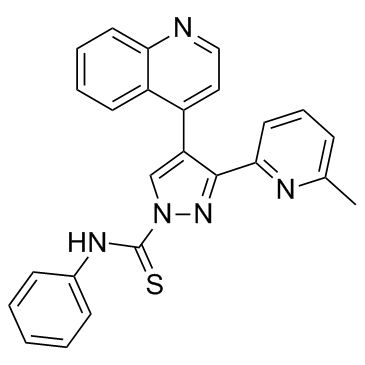| Description |
A 83-01 is a potent inhibitor of TGF-β type I receptor ALK5 kinase, type I activin/nodal receptor ALK4 and type I nodal receptor ALK7, with IC50s of 12, 45 and 7.5 nM, respectively.
|
| Related Catalog |
|
| Target |
IC50: 12 nM (ALK5, cell-based), 45 nM (ALK4 cell-based), 7.5 nM (ALK7 cell-based)[1]
|
| In Vitro |
A 83-01 is a potent inhibitor of TGF-β type I receptor ALK5 kinase, type I activin/nodal receptor ALK4 and type I nodal receptor ALK7, reduces the level of ALK-5-induced transcription with an IC50 of 12 nM in Mv1Lu cells, also blocks the ALK4-TD and ALK7-TD induced transcription with IC50s of 45 nM and 7.5 nM in R4-2 cells, and weakly suppresses that induced by constitutively active ALK-6, ALK-2, ALK-3, and ALK-1. A 83-01 (0.03-10 µM) potently prevents the growth-inhibitory effects of TGF-β, and completely inhibits the effect at 3 µM. A 83-01 (1-10 µM) inhibits TGF-β-induced Smad activation in HaCaT cells[1]. A 83-01 (1 µM) decreases cell motility, adhesion and invasion increased by TGF-β1 in HM-1 cells, but does not change cell proliferation[2].
|
| In Vivo |
A 83-01 (50, 150 and 500 μg/mouse, i.p.) significantly improves survival of the mice without body weight or neurobehavioral appearances[2]. A 83-01 (0.5 mg/kg, i.p.) shows a significantly strong antitumor effect in mice bearing M109 cells[3].
|
| Cell Assay |
HM-1 cells are seeded into a 96-well plate and are incubated for 18 hr. A 83-01 (1 μM) or vehicle are then added for 12 hr followed by the addition of TGF-β1 (1 ng/mL) or vehicle for 60 hr. The number of viable cells in each well is examined using the WST-1 assay[2].
|
| Animal Admin |
Mice[2] Female B6C3F1 mice used for the in vivo studies are maintained under specific pathogen-free conditions. To evaluate the effect of A 83-01 on the survival of mice bearing peritoneal dissemination, HM-1 cells (1×106) are injected into the abdominal cavity via the left flank of the mouse. Starting the next day, A 83-01 (150 μg/body) or vehicles (PBS with 0.5% DMSO) are injected into the abdominal cavity three times per week. Mice are euthanized before reaching the moribund state[2].
|
| References |
[1]. Tojo M, et al. The ALK-5 inhibitor A-83-01 inhibits Smad signaling and epithelial-to-mesenchymal transition by transforming growth factor-beta. Cancer Sci. 2005 Nov;96(11):791-800. [2]. Yamamura S, et al. The activated transforming growth factor-beta signaling pathway in peritoneal metastases is a potential therapeutic target in ovarian cancer. Int J Cancer. 2012 Jan 1;130(1):20-8. [3]. Taniguchi Y, et al. Enhanced antitumor efficacy of folate-linked liposomal doxorubicin with TGF-β type I receptor inhibitor. Cancer Sci. 2010 Oct;101(10):2207-13.
|


